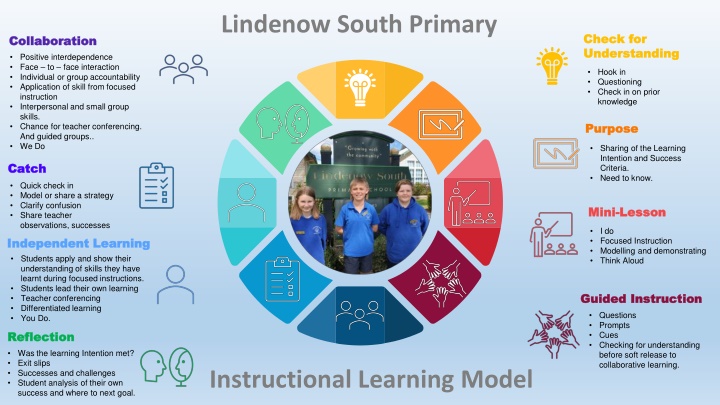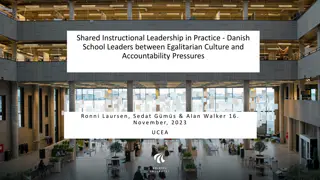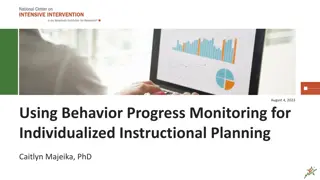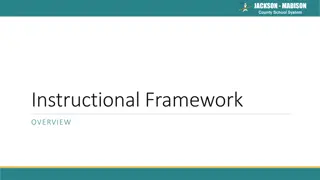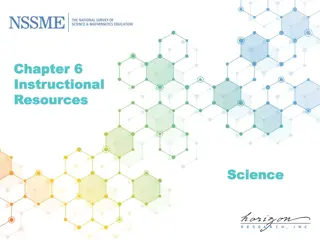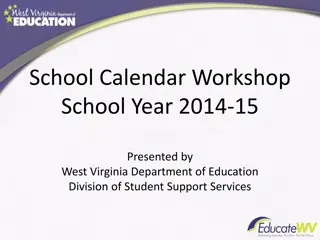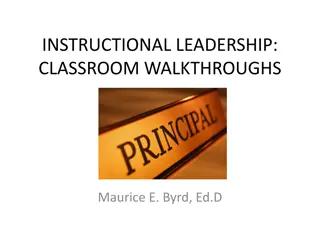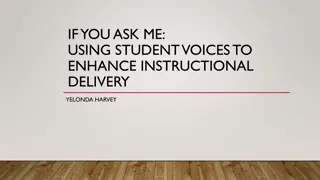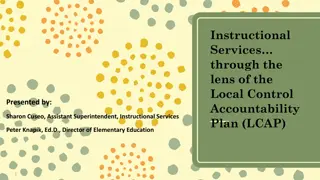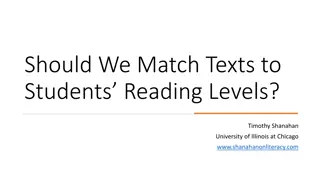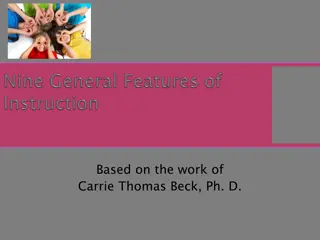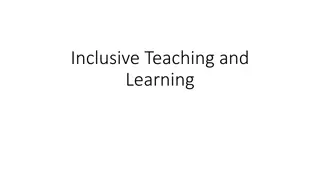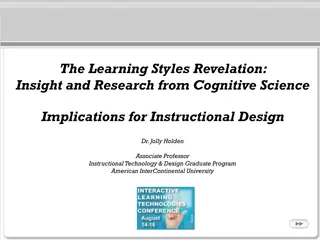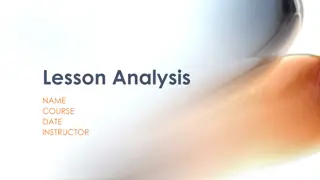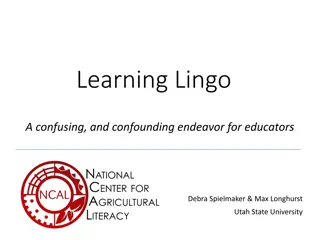Lindenow South Primary - Instructional Learning Strategies
Create a structured learning environment at Lindenow South Primary through collaborative activities and individual accountability. The model emphasizes metacognitive strategies, differentiated teaching, and multiple exposures for student success. Implement high-impact teaching strategies for effective learning outcomes. Focus on understanding, application, and reflective practices to enhance student engagement and achievement.
Download Presentation

Please find below an Image/Link to download the presentation.
The content on the website is provided AS IS for your information and personal use only. It may not be sold, licensed, or shared on other websites without obtaining consent from the author.If you encounter any issues during the download, it is possible that the publisher has removed the file from their server.
You are allowed to download the files provided on this website for personal or commercial use, subject to the condition that they are used lawfully. All files are the property of their respective owners.
The content on the website is provided AS IS for your information and personal use only. It may not be sold, licensed, or shared on other websites without obtaining consent from the author.
E N D
Presentation Transcript
Lindenow South Primary Check for Check for Understanding Understanding Collaboration Collaboration Positive interdependence Face to face interaction Individual or group accountability Application of skill from focused instruction Interpersonal and small group skills. Chance for teacher conferencing. And guided groups.. We Do Hook in Questioning Check in on prior knowledge Purpose Purpose Sharing of the Learning Intention and Success Criteria. Need to know. Catch Catch Quick check in Model or share a strategy Clarify confusion Share teacher observations, successes Mini Mini- -Lesson Lesson I do Focused Instruction Modelling and demonstrating Think Aloud Independent Learning Independent Learning Students apply and show their understanding of skills they have learnt during focused instructions. Students lead their own learning Teacher conferencing Differentiated learning You Do. Guided Instruction Guided Instruction Questions Prompts Cues Checking for understanding before soft release to collaborative learning. Reflection Reflection Was the learning Intention met? Exit slips Successes and challenges Student analysis of their own success and where to next goal. Instructional Learning Model
Lindenow South Primary Instructional Learning Model Check for Check for Understanding Understanding Reflection Reflection Purpose Purpose Independent Learning Independent Learning Mini Mini- -Lesson Lesson Guided Instruction Guided Instruction Catch Catch Collaboration Collaboration
Connection to High Impact Teaching Strategies (HITS) Check for Understanding Check for Understanding Metacognitive Strategies Metacognitive Strategies Purpose Purpose Setting Goals Setting Goals Structuring Lessons Structuring Lessons Reflection Reflection Questioning Questioning Feedback Feedback Mini Mini- -Lesson Lesson Explicit Teaching Explicit Teaching Worked Examples Worked Examples Independent Learning Independent Learning Questioning Questioning Metacognitive Strategies Metacognitive Strategies Differentiated Teaching Differentiated Teaching Multiple Exposures Multiple Exposures Feedback Feedback Guided Instruction Guided Instruction Explicit Teaching Explicit Teaching Questioning Questioning Collaborative Learning Collaborative Learning Catch Catch Questioning Questioning Feedback Feedback Collaboration Collaboration Collaborative Learning Collaborative Learning Multiple Exposures Multiple Exposures Feedback, Questioning Feedback, Questioning
Lindenow South Primary Instructional Learning Model Check for Understanding Check for Understanding What do students already know? What do students need to know. What is the teacher doing? Questioning Reviewing previous learning could be through a daily review. Hooking students in with a quiz, game, challenge or task to evaluate prior learning. Providing time for students to switch their thinking to the curriculum area of learning. Activate prior knowledge for purpose. What are the students doing? Actively participating in discussions. Working with required tools e.g., mini whiteboards. Sharing or showing their understanding verbally or in writing. Activate You do, I watch (Mastery) I do, I do, you help You do, I help Review Prior Knowledge for Purpose you watch
Lindenow South Primary Instructional Learning Model What is the teacher doing? Displaying the learning intention. Showing, reading and explaining the Learning Intention for the lesson. Sharing the success criteria which is visual to students or co-creating the success criteria with the students. Success criteria is on display or provided to students so learning can be monitored. Purpose Purpose The teacher shares the learning intention and success criteria. They build the need to know for the lesson. Students will be explicitly explained what they are learning and why and how they can be successful learners during the lesson. It is the teacher's role to display or provide the learning intention and success criteria for their students. It is not the student's role to copy these down. Copying will stagnate the flow of the instructional model and delay valuable teaching time What are the students doing? Actively listening Clarifying understanding through questioning Making sure they have access to the LI and SC to monitor their learning. Developing an understanding of what they are learning for the lesson.
Lindenow South Primary Instructional Learning Model What is the teacher doing? Demonstrates the learning intention and success criteria by modelling. Developing anchor charts Read alouds Think alouds Make links to prior learning to make a connection to the new learning. Demonstrate the skill, strategy, or procedure you are teaching step-by-step. Use explicit language Showing what to do and how to do it. Checks for understanding before transiting to the next learning phase. Mini-Lesson Mini-lesson where the teacher explicitly teaches a skill or strategy. Students are shown the WHAT and HOW to do the skill/s they will master with support and practice independently. Here the teacher will model, and the students will watch (I do, you watch) The predictability of the mini-lesson format is important. Not only does it let your students know how each lesson will go, it promotes student independence. The sequence and critical components for each mini-lesson are: Connection Teach Active Engagement Link - Heather Clayton, the author of Making the Standards Come Alive! What are the students doing? Actively listening Sitting together on the floor/tables or scattered but in clear view of the teacher. Free of distraction. Questioning or sharing thinking. Note-taking I do you watch
Lindenow South Primary Instructional Learning Model What is the teacher doing? Roaming One on one check ins. Working with a small group of students who have indicated they require further clarification or support with the new concept. Monitoring time. Making notes on future teaching points. Guided Instruction Students will try out the skill, strategy, or procedure for themselves. What the teacher asks students to do should mirror what has been demonstrated the skill, strategy, or procedure. Student engagement could be students applying what was taught in the mini- lesson on their own, in a small group or talking with a partner about how they plan on using the strategy. What are the students doing? Talking with a partner Applying understanding. Questioning any misunderstandings Ever students has an opportunity to have a go at the new skill, strategy or procedure. Showing understanding via routine (thumbs up), feedback slip, reflection stuck. I do, you help
Lindenow South Primary Instructional Learning Model What is the teacher doing? Provides opportunities to apply students' new knowledge. Facilitates invitational or guided small groups. Roaming conferences one on one or table talk groupings. Taking anecdotal notes to record further teaching. Roams providing enabling prompts for struggling students and extending prompts for advancing students. Offering feedback verbally based on observations. Collaboration Collaboration Collaborative and/or independent Practice/Learning The students apply the skills from the minilesson to develop/demonstrate their level of understanding. This could be in small guided groups, invitational teacher groups, in partners or independently. What are the students doing? Applying and demonstrating their level of understanding. Monitoring their learning against the success criteria. Identifying learning needs to join invitational groups and to extend their understanding. Working in small groups, partners or independently. The teacher confers with individuals and small groups to learn more about their understanding and application of the skill in order to provide the appropriate scaffolds. You do, I help.
Lindenow South Primary Instructional Learning Model What is the teacher doing? Monitoring time, this can only be a short sharp check in of no more than 5 8 mins. Checking understanding through questioning Sharing observations. Actively listening to student feedback Offering feedback based on observations Celebrating successes Reviewing the learning intention and success criteria. Catch Catch A quick, whole class time out from students learning time to model or share a strategy that will help them re-engage successfully with the task. Can be used to clarify confusion, misconceptions and share the teacher s observations of the learning. (successes). This can also be time to transition students into the independent learning phase of the instructional learning model. Students move from practicing their new learning into applying it to independent texts or resources. What are the students doing? Actively listening to others share or teacher feedback. Sharing to the class Notetaking new strategies that may be come up. Offering feedback Checking their progress against the success criteria.
Lindenow South Primary Instructional Learning Model What is the teacher doing? Conducting scheduled student conferences. Facilitating a small invitational group. In literacy evaluating book clubs or literacy circles. Monitoring student learning goals. Taking anecdotal notes for assessment purposes and future teaching goals. Independent Learning Independent Learning The students apply the skills they have learnt from the days minilesson or previous minilessons. They do this to develop/demonstrate their level of understanding in an independent context. Choice encourages student voice as they can select the means of practicing the skill. What are the students doing? Monitoring individual learning goals Showing understanding of previously taught skills and strategies. They are prepared for individual conferences Working independently with limited to no support. The teacher confers with individuals and small groups to both individualise and differentiate the learning. Guidance is matched to student needs The support gradually tapers as students develop skills of time-management, planning and self-reliance. Teachers set assignments or tasks to be completed each week in this independent learning time.
Lindenow South Primary Instructional Learning Model What is the teacher doing? Facilitating discussion Recording any information that may support future lesson planning or small group collaborations. Reserving the temptation to offer critical feedback, this is for conferences. Should be an expert questioner, rather than provider of answers Teacher must engage and direct students to effectively collect, understanding and synthesize information What are the students doing? Leading the reflective discussion Sharing successes and challenges. Piggy backing off each others thinking Evaluating learning goals. Measuring success against the success criteria Actively participating. Providing feedback based in skills and strategies. Reflection Reflection This is one of the most important phases of the instructional learning model. It is a time for reviewing. The reflection should provide a time for students to share and synthesise learning. What did the students accomplish? What do they need next? The teacher is the facilitator and should try not to lead the reflective time. Students are provided with an opportunity to measure themselves against the success criteria, re-evaluate learning goals and acknowledge challenges they have experienced. Reflection time can happen in small table talk groups, turn and talk with a partner, whole class reflection circles or through an evaluation template or exit slip. Review
